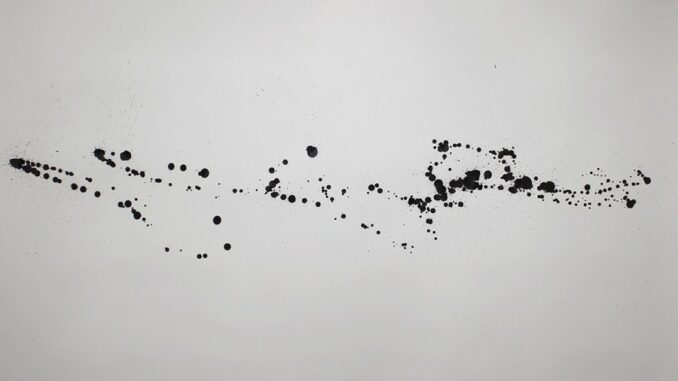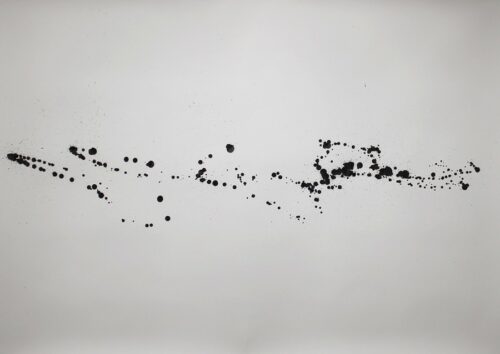
As a protest in Duchamp’s urinal, a suspension for Serrano’s Christ, or a patina for Rodin’s bronze, piss holds a special place in the heart of art history. Body fluid has long established itself as a vehicle to grab attention, evoke disgust and make associative statements on consumption and value. Yet having become associated with empty artistic calories and mounting tabloid inches, Post-Piss Christ, what can bodily expulsion in art do beyond the sampling of old shock tactics?
Pissed Ink at Platform Arts, Belfast, mounts its medium headfirst but employs it in an unexpectedly subtle way. The result of black ink injected into the bladder and pissed onto cartridge paper, the dripped and flicked marks are surprisingly delicate. Some works appear as inverted photographs of galaxies and constellations, isolated in the page, whilst others recall retina burn from fireworks.
Peter Spiers is interested in the interaction of art and empathy, where the performative process of pissing ink causes individuals to project themselves into the creation of the work. As a woman I am less empathetic to the process behind the marks created, but also draw other visual comparisons with spotting and menstruation. Each work resembles and behaves as a Rorschach print, calling upon the viewer’s projective interpretation of both process and aesthetic.
Each visual quality in these works becomes a second guess: the shiny stickiness of the marks, inherent to neat ink, becomes questionable in source. Just how much the aesthetic has been obliterated by the ink, or enhanced by bodily fluid, is unknowable – indeed, how much urine features at all cannot be visually deciphered. The paper occupies the same space as the viewer, both repellent and appealing for closer inspection.
I also believe that the gender dialogue in this exhibition runs to deeper levels than that of human biology. Through sparse monochromatic marks and the adoption of the floor-based splatter technique that was Pollock’s hallmark, Spiers creates an amalgamation and pastiche of “opposing” and male-centric movements in art history, minimalism and abstract expressionism. With the penis adopted as an artistic vehicle, Spiers literally and permanently marks the paper’s territory.
The delicacy of the marks of these pieces provides a foil to the phallo-centricity of the process. In this sense, Pissed Ink finds contemporary relevance beyond an empty shock – through the layered, complimentary and ambiguous dialogues it presents. In this alignment of process and aesthetic, when such a historical medium encounters its traditional counterpart via a urethra, it carries with it the old and new histories of mark making, performance, and human nature.


Leave a Reply